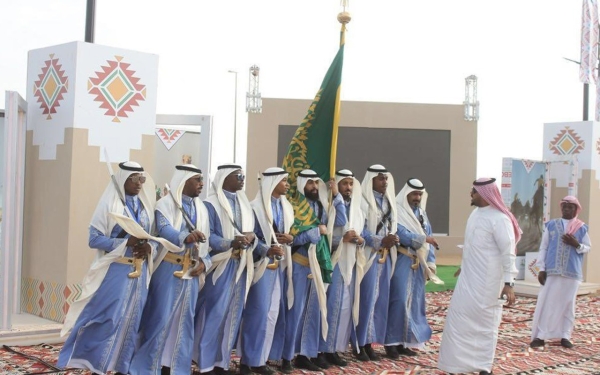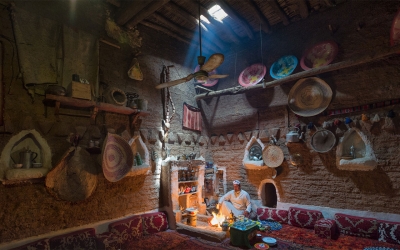
The Saudi Ardah Flag is a large banner that stands in the midst of rows of Ardah performers during the Saudi Ardah performance in official celebrations in the Kingdom of Saudi Arabia. It is called 'al-Bairaq' and is a fundamental component of the Ardah, with a width equal to two-thirds of its length. It features the spearhead, finial, and chains. The Saudi Ardah is performed with two rows of men opposite of one another, swords in hand, except for the flag-bearer, and is accompanied by the beating of the drums and the recitation of war chants.
The responsibility of bearing the Saudi Ardah flag is entrusted to a specific individual known as al-Bairaq bearer. This role is often inherited from his fathers and ancestors, and he, in turn, passes it down to his sons and grandchildren. Bearing the flag is considered an honor for them and serves as a tribute to their father's memory. The Ardah has poets, both ancient and modern, such as Mohammed al-Aouni, Fahid Bin Duhayyim, Nasser al-Oraini, Abdullah al-Subai, Abdulrahman al-Bawardi, Abdulrahman al-Safiyan, and others. Leading the Ardah vocally are the chant of Abdulrahman Bin Safiyan in al-Wadiah War, Ya Habeel al-Ra'i, renowned for its beginning 'Nahmad Allah Jat Ala Ma Tamanna,' and the chant of Fahid Bin Duhayyim, "Hin Hal al-Adat", known for its beginning 'Najd Shamit'.
Specifications of the Saudi Ardah flag
The National Center for Saudi Ardah has outlined the specifications for the flag (banner) used by Saudi Ardah groups during their participation in both public and private events. These specifications include ensuring that the flag has a proper appearance, (avoiding signs of being old or wrinkled) and maintaining a suitable size, (not less than 120 by eighty cm). It should not touch the ground or be flown at half-mast. Additionally, the bearer of the flag should adhere to Ardah attire, possess a strong physique, be skilled in Ardah, and demonstrate quick-wittedness. The flagpole should be held on the left side, with the flag placed on the right shoulder, and the spearhead and finial should top the flagpole.
The importance of Saudi Ardah
The Ardah was traditionally performed as a declaration and preparation for war, serving to motivate courage and remind of strength and bravery. However, with the prevalence of peace and security, it has transformed into a performative art in national and private events. In 2015, the Saudi Ardah was inscribed on the United Nations Educational, Scientific, and Cultural Organization (UNESCO) Representative List of the Intangible Cultural Heritage of Humanity. The National Center for the Saudi Ardah was established in 2017 at the King Abdulaziz Foundation for Research and Archives (Darah) to promote the folk arts associated with the Ardah tradition in the Kingdom.
Related quizzes
Related articles


